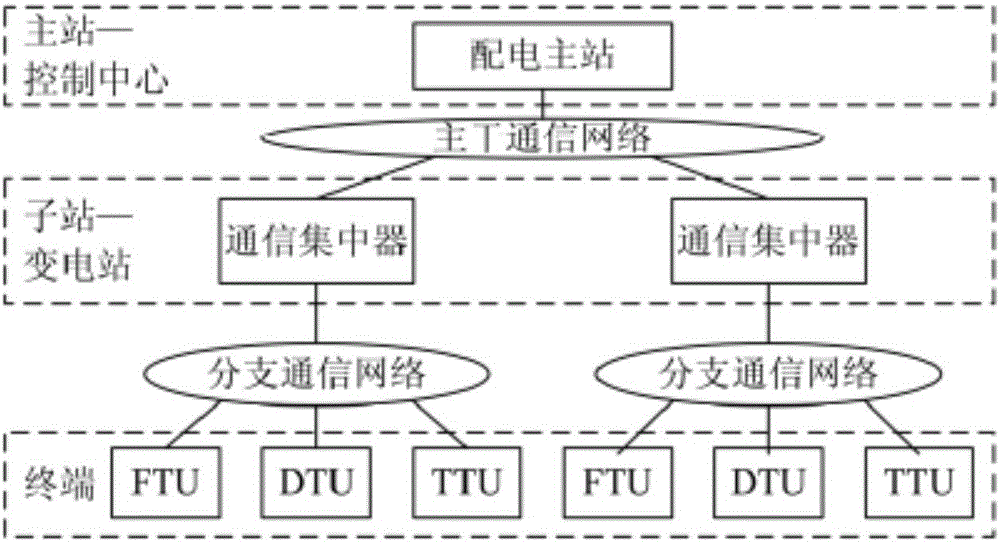Bidirectional allowable protection method employing master station to identify dynamic topology for power distribution circuit
A permissive protection and dynamic topology technology, applied in the direction of emergency protection circuit devices, electrical components, etc., can solve the problem that the outlet circuit breaker does not participate in signal transmission or reception, etc., to achieve accurate positioning, reduce fault hazards, and accurately The effect of quick positioning
- Summary
- Abstract
- Description
- Claims
- Application Information
AI Technical Summary
Problems solved by technology
Method used
Image
Examples
Embodiment 1
[0039] 1. Line equipment configuration
[0040] Generally, the distribution network in the hand-in-hand link is a closed-loop design and an open-loop operation. The system structure is as follows figure 1 shown. It is powered by two power sources A and B, and each circuit breaker is installed with a corresponding FTU. Among them, , is the outlet circuit breaker, and the outlet protection equipment does not participate in the receiving or sending of the permission signal, and the corresponding outlet protection is CB1, CB7; , is the outlet For the next circuit breaker of the circuit breaker, the corresponding FTU2 and FTU6 are defined as boundary FTUs. According to the operating conditions, the master station recognizes them as the beginning or end FTUs; The FTU3, FTU4, FTU5, and FTU8 are middle FTUs, and FTU8 only participates in the reception or transmission of the permission signal when the LB is closed; in normal operation, the LB is in the open state, and the two sides ar...
Embodiment 2
[0068] The difference from the embodiment is that the load is transferred, and the areas 1, 2, 3, and 4 are transferred by the B power supply.
[0069] At this time the contact switch LB is closed, as attached Figure 4 As shown, the border FTU2 is recognized by the master station as the tail end FTU, and the border FTU6 is recognized by the master station as the head end FTU.
[0070] 1) If a short circuit fault occurs at k3,
[0071] Only CB7 feels the overcurrent. Other FTUs cannot feel the overcurrent, and the corresponding circuit breaker cannot operate. After the delay time, CB7 can still feel the overcurrent, control the exit circuit breaker to trip, and successfully remove the fault at line k4.
[0072] 2) If a short circuit fault occurs at k2,
[0073] CB7, head-end FTU6, intermediate FTU5, intermediate FTU8, and intermediate FTU4 sense overcurrent and send inquiry signals to adjacent FTUs.
[0074] At this moment, FTU3 does not feel the overcurrent, and sends a ...
Embodiment 3
[0080] The difference from Example 1 is that the load is transferred, areas 3 and 4 are transferred by B power supply, and areas 1 and 2 are still powered by A power supply
[0081] At this time, the contact switch LB is closed, and QF3 is normally open. Figure 5 As shown, the border FTU2 is recognized by the master station as the originating FTU, and the border FTU6 is also recognized as the originating FTU by the master station. The following analysis only takes the B power supply area as an example.
[0082] 1) If a short circuit fault occurs at k3,
[0083] Only CB7 feels the overcurrent. After the delay time, CB7 can still feel the overcurrent, control the exit circuit breaker to trip, and successfully remove the fault at line k4.
[0084] 2) If a short circuit fault occurs at k2,
[0085] CB7, head-end FTU6, intermediate FTU5, intermediate FTU8, and intermediate FTU4 sense overcurrent and send inquiry signals to adjacent FTUs.
[0086] At the moment, FTU3 does not ...
PUM
 Login to View More
Login to View More Abstract
Description
Claims
Application Information
 Login to View More
Login to View More - R&D
- Intellectual Property
- Life Sciences
- Materials
- Tech Scout
- Unparalleled Data Quality
- Higher Quality Content
- 60% Fewer Hallucinations
Browse by: Latest US Patents, China's latest patents, Technical Efficacy Thesaurus, Application Domain, Technology Topic, Popular Technical Reports.
© 2025 PatSnap. All rights reserved.Legal|Privacy policy|Modern Slavery Act Transparency Statement|Sitemap|About US| Contact US: help@patsnap.com



